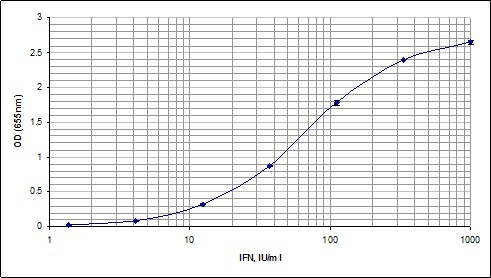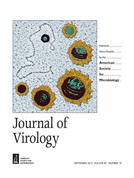- Submit a Protocol
- Receive Our Alerts
- Log in
- /
- Sign up
- My Bio Page
- Edit My Profile
- Change Password
- Log Out
- EN
- EN - English
- CN - 中文
- Protocols
- Articles and Issues
- For Authors
- About
- Become a Reviewer
- EN - English
- CN - 中文
- Home
- Protocols
- Articles and Issues
- For Authors
- About
- Become a Reviewer
IFN-α/β Detection Assay Using Sensor Cell Lines
Published: Vol 4, Iss 10, May 20, 2014 DOI: 10.21769/BioProtoc.1130 Views: 12054
Reviewed by: Anonymous reviewer(s)

Protocol Collections
Comprehensive collections of detailed, peer-reviewed protocols focusing on specific topics
Related protocols

Mass Spectrometry-based Lipidomics, Lipid Bioenergetics, and Web Tool for Lipid Profiling and Quantification in Human Cells
Liang Cui [...] Kuan Rong Chan
Aug 20, 2023 2984 Views

Cell-Sonar, an Easy and Low-cost Method to Track a Target Protein by Expression Changes of Specific Protein Markers
Sabrina Brockmöller [...] Simone Rothmiller
Feb 5, 2025 1633 Views

Cluster FLISA—A Method to Compare Protein Expression Efficiency Between Cell Lines and Subunit Clustering of Proteins
Sabrina Brockmöller and Lara Maria Molitor
Nov 5, 2025 1186 Views
Abstract
Type I interferons (IFN-α/β) play an important role in host resistance to viral infections. Signaling through the JAK-STAT pathway, IFN-α/β stimulates response elements (ISRE) in the promoters of ISG to regulate their expression (reviewed in Reference 2). This method was adapted from InvivoGen to specifically detect and quantify IFN-α/β secreted in response to virus infection. HEK-Blue™ IFN-α/β cells were generated by stably introducing the human STAT2 and IRF9 genes into HEK293 cells to obtain a fully active type I IFN signaling pathway. The activation of this pathway is made detectable by the addition of a reporter gene expressing a secreted embryonic alkaline phosphatase (SEAP) under the control of the ISG54 promoter. ISG54 is a well-known ISG activated through an ISRE-dependent mechanism by type I IFNs.
Materials and Reagents
- HEK-BlueTM IFN-α/β cells (InvivoGen, catalog number: hkb-ifnab )
- QUANTI-Blue (InvivoGen, catalog number: rep-qb2 )
- IFN-α2 (PBL Biomedical Laboratories, catalog number: PBL 11105-1 )
- Dulbecco’s Modified Eagle’s Medium (DMEM) (PAA Laboratories GmbH)
- Fetal Calf Serum (FCS) (Biochrom)
- PBS (Naxo OÜ)
- Trypsin/EDTA (GE Healthcare)
- 100x Penicillin-Streptomycin (Naxo OÜ)
- Normocin (InvivoGen, catalog number: ant-nr-1 )
- Zeocin (InvivoGen, catalog number: ant-zn-1 )
- Blasticidin (Sigma-Aldrich, catalog number: 3513-03-9 )
Equipment
- 96-well plate
- 37 °C, 5% CO2 cell culture incubator
- Microscope
- UV cross-linker (Hoefer, model: UVC5000 )
- Tecan SunriseTM microplate reader
Procedure
- Cells and media
HEK-BlueTM IFN-α/β cells were maintained in DMEM containing 10% heat-inactivated FCS, 50 U/ml penicillin, 50 μg/ml streptomycin, and 100 μg/ml Normocin in a humidified incubator at 37 °C under 5% CO2. HEK-BlueTM IFN-α/β cells should not be passaged more than 20 times to remain fully efficient. HEK-BlueTM IFN-α/β cells should be maintained with two selective antibiotics, Zeocin (100 mg/ml) and Blasticidin (30 μg/ml). Do not use selective antibiotics for the test procedure. Cells should be passaged when a 70-80% confluency is reached.
- Interferon detection
Day 1- Add 50 µl of each sample per well of a flat-bottom 96-well plate. If infectious virus is present in the collected samples, it should be inactivated using UV cross-linker for 5 min at 1,000 μJ/cm2.
The sample of the 96-well plate with standards, samples and negative controls (see next steps for the details). “Mock” indicates the same amount of media, but from uninfected cells. “Neg.c.” indicates negative control and described below.
IFN (1)
IFN (1)
IFN (1)
Sample 1
Sample 1
Sample 1
IFN (2)
IFN (2)
IFN (2)
Sample 2
Sample 2
Sample 2
IFN (3)
IFN (3)
IFN (3)
Sample 3
Sample 3
Sample 3
IFN (4)
IFN (4)
IFN (4)
Sample 4
Sample 4
Sample 4
IFN (5)
IFN (5)
IFN (5)
Sample 5
Sample 5
Sample 5
IFN (6)
IFN (6)
IFN (6)
Mock
Mock
Mock
IFN (7)
IFN (7)
IFN (7)
Neg.c. 1
Neg.c. 1
Neg.c. 1
IFN (8)
IFN (8)
IFN (8)
Neg.c. 2
Neg.c. 2
Neg.c. 2
- Add 50 µl of IFN-α or IFN-β dilutions (1-8).
1
2
3
4
5
6
7
8
10,000 U/ml
3,333 U/ml
1,111 U/ml
370 U/ml
123 U/ml
41 U/ml
13.7 U/ml
4.6 U/ml
75 µl of 104 IU/ml
50 µl DMEM
50 µl DMEM
50 µl DMEM
50 µl DMEM
50 µl DMEM
50 µl DMEM
50 µl DMEM
Transfer 25 µl to each next well to make 1:3 dilutions as demonstrated in the table above. To prepare the dilutions, use the same DMEM as for the maintenance of HEK-BlueTM IFN-α/β cells (no selective antibiotics needed for this step).
- Suggested negative controls: (1) 50 µl of IFN-γ at 104 U/ml in one well, (2) 50 µl of UV-inactivated medium from virus infected IFN-α/β-negative cell line (like BHK-21) with titer of virus similar to samples used in the same experiment.
- Prepare suspension of HEK-BlueTM IFN-α/β cells at ~280,000 cells per ml in test medium (DMEM containing 10% heat-inactivated FCS, 50 U/ml penicillin, 50 μg/ml streptomycin, and 100 μg/ml Normocin).
- Add 180 µl of cell suspension (~50,000 cells) per well.
- Incubate the plate at 37 °C in a CO2 incubator for 20-24 h.
- Prepare QUANTI-BlueTM reagent following the instructions on the package.
- Add 180 µl of resuspended QUANTI-BlueTM reagent per well of a flat-bottom 96-well plate.
- Add 50 µl of supernatant from induced HEK-BlueTM IFN-α/β cells.
- Incubate the plate for 1-3 h at 37 °C in CO2 incubator.
- Determine SEAP levels using a spectrophotometer (Tecan Sunrise plate reader) at 620-655 nm.
- Calculations should be performed using plots drawn separately for each range of obtained values. Please note that the curve is not linear and IFN values should be within the detection range, otherwise use dilutions of initial samples.
Representative curve obtained in one of the experiments is shown below. Please note that in given experimental conditions higher concentrations of IFN (1,000-10,000) reach the plateau level and dilutions of initial samples are strongly recommended:

Note: manufacturer recommends using 20 µl of sample volume (day 1) and 20 µl of supernatant (day 2), but we found that increased volumes (50 µl) improved the reproducibility of the results.
- Add 50 µl of each sample per well of a flat-bottom 96-well plate. If infectious virus is present in the collected samples, it should be inactivated using UV cross-linker for 5 min at 1,000 μJ/cm2.
Notes
- All specific product information and guidelines can be found at the manufacturer’s website:
http://www.invivogen.com/hek-blue-ifn-ab.
- Cell line stability
It is critical to prepare an adequate number of frozen stocks at early passages. HEK-BlueTM IFN-α/β cells should not be passaged more than 20 times to remain fully efficient. HEK-BlueTM IFN-α/β cells should be maintained in growth medium supplemented with the two selective antibiotics, ZeocinTM (100 mg/ml) and Blasticidin (30 μg/ml). Antibiotic pressure with Blasticidin is required to maintain the plasmid coding for human STAT2 and IRF9 genes, and ZeocinTM is required to maintain the plasmid coding for SEAP.
Acknowledgments
This protocol was published in the original paper by Lulla et al. (2013). This work was supported by Estonian Science Foundation grants 7501, 7407, and9421; target financing project SF0180087s08; and the European Union through the European Regional Development Fund via the Center of Excellence in Chemical Biology.
References
- Lulla, V., Karo-Astover, L., Rausalu, K., Merits, A. and Lulla, A. (2013). Presentation overrides specificity: probing the plasticity of alphaviral proteolytic activity through mutational analysis. J Virol 87(18): 10207-10220.
- Randall, R. E. and Goodbourn, S. (2008). Interferons and viruses: an interplay between induction, signalling, antiviral responses and virus countermeasures. J Gen Virol 89(Pt 1): 1-47.
Article Information
Copyright
© 2014 The Authors; exclusive licensee Bio-protocol LLC.
How to cite
Lulla, V., Merits, A. and Lulla, A. (2014). IFN-α/β Detection Assay Using Sensor Cell Lines. Bio-protocol 4(10): e1130. DOI: 10.21769/BioProtoc.1130.
Category
Microbiology > Microbe-host interactions > Virus
Biochemistry > Protein > Expression
Do you have any questions about this protocol?
Post your question to gather feedback from the community. We will also invite the authors of this article to respond.
Share
Bluesky
X
Copy link












